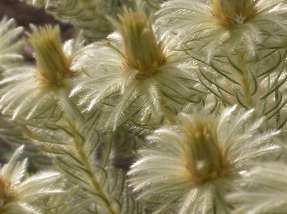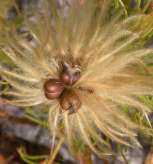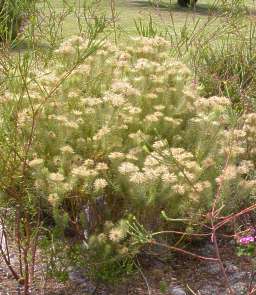Phylica pubescens
Phylica pubescens Aiton
Family: Rhamnaceae
Common names: featherhead (Eng.); veerkoppie (Afr.)
Introduction
This attractive bush is densely covered with hairy leaves and each hair seems to gather the sunlight and make it glow. Early morning or late afternoon sun shining behind the featherhead bush makes all other plants dull by comparison!

Description
Description
The branches of this erect, 1.2-2 m tall bush are clothed with leathery, hair-covered narrow leaves, which become crowded at the branch tips. Each branch ends in a flattened flowerhead, comprising rings of feathery bracts amongst which the tiny flowers nestle. These flowers are white with long brownish tips and have a faint cinnamon scent. They flower in autumn and winter (May to August), but the flowers themselves are not particularly noticeable unless viewed from close up. It is the buff or grey-coloured bracts amongst which they are situated that attract attention.

The flowers are followed by fruits, which turn from green to brown when ripe (in October and November). These are hard, 3-valved capsules which split open to each release a dark brown seed with an elaiosome (appendage which attracts animals/insects) attached.
Distribution and habitat
Distribution description
From the Cape Peninsula as far east as Albertinia on dry, lower, limestone and sandstone slopes and flats.
Derivation of name and historical aspects
History
The flowering tips are surrounded by densely feathery bristles, which give rise to the common names in both English and Afrikaans; pubescens, as part of the scientific name, well describes the hairy nature of the plant.
Both Phylica pubescens and the fairly similar P. plumosa were grown in European gardens from the 17th-18th centuries. Considering how striking these species are, it is not surprising that P. plumosa was amongst the first of the dried specimens to reach Europe from the Cape.
There are about 150 species occurring in Africa and Madagascar as well as some of the South Atlantic islands. There is one species on Tristan da Cuhna. There are many attractive species of Phylica, all displaying hard leathery leaves from which the general family name of hardeblaar, meaning hard-leaved, comes from.

Ecology
Ecology
Different species of bees, flies and beetles can be seen in abundance on the flowering heads of P. pubescens, all presumably effecting pollination The flowering heads are a happy and productive hunting ground for white to yellowish coloured crab spiders whose pale colouring prevents them from being seen by the various insects visiting the flowers. The fruit, which ripens in early summer, is hard and splits open to release seeds which each have an appendage called an elaiosome which is very attractive to ants. Ants collect the seed and take them to their nests, thus aiding seed dispersal. This may be one of the reasons it is not more available in the nursery trade-seed collectors need to be vigilant and arrive before the ants do!
Uses
Use
Featherhead is popular in posies and flower arrangements, is long lasting as a fresh cut-flower, dries very well and so is also popular in the dried flower trade. Horticulturally it is a fantastic filler plant, setting off the better-known proteas, ericas and restios to perfection. It would also make a suitable specimen plant where its sun-catching properties can be admired from various angles.

Growing Phylica pubescens
Grow
Seeds should be collected in October/November and then sown in March/April in a well-drained seedling mix. They should be kept damp, not wet. Transplant into a well-drained sandy mix when about 30 mm tall. Plant out into an acid, sandy, well-drained sunny area in the garden, and water regularly until established. Small plants transplant better than big ones into the final planting position. In the winter rainfall area it should cope without too much water once it is established, making it an ideal waterwise plant. In summer rainfall areas this plant should receive some water during autumn, winter and spring months also.
Place the plants in the garden where either early morning or late afternoon (or preferably both) sunshine can backlight the plant to best advantage. Companion plantings of proteas, ericas and restios are obvious choices for the fast-growing featherhead, but this decorative plant will grow happily among other plants as well, as long as the soil is well drained. It can also be grown in containers. Lightly prune back in late spring to maintain a compact shape and prevent the plants from becoming woody. Collect seed so that new plants can be set out every four to five years as they are at their loveliest when young; they become woody and leggy when older.
References
- Adamson, R.S. & Salter, T.M. (eds). 1950. Flora of the Cape Peninsula. Juta, Cape Town.
- Kidd, M.M. 1983. Cape Peninsula . South African Wild Flower Guide 3. Botanical Society of South Africa, Cape Town.
- Smith, C.A. 1966. Common names of South African plants. Memoirs of the Botanical Survey of South Africa No. 35.
- Van Der Spuy, U. 1973. Gardening with shrubs. Hugh Keartland, Johannesburg.
Credits
Jane Forrester
Harold Porter National Botanical Garden
December 2004
Plant Attributes:
Plant Type: Shrub
SA Distribution: Western Cape
Soil type: Sandy, Clay
Flowering season: Autumn, Winter
PH: Alkaline, Neutral
Flower colour: White
Aspect: Full Sun, Morning Sun (Semi Shade)
Gardening skill: Average
Special Features:
Horticultural zones







Rate this article
Article well written and informative
Rate this plant
Is this an interesting plant?
Login to add your Comment
Back to topNot registered yet? Click here to register.